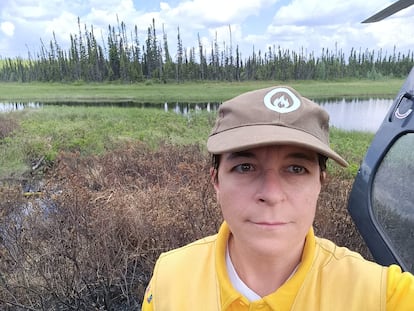Firefighters in Canada: ‘They are gigantic blazes and they will burn all summer’
European volunteers sent to Quebec province are facing ‘monsters of fire’ greater than anything they ever experienced back home

Chibougamau is a Canadian town full of single-family homes with their lawns and their driveways, nestled between numerous lakes and lush forests. Over the last two weeks, this idyllic setting has become the base of operations for around 100 Spaniards — forestry technicians and firefighters — who have been sent to Quebec province to deal with fires of tremendous magnitude. “What we are seeing in Canada is next-level wildfires that we are not used to. These are bigger monsters than we have ever seen in Spain, and they are going to be burning all summer,” says Ángela Iglesias, the liaison officer for the Spanish team sent on June 14 to help the firefighting effort.
Across Canada, 490 fires are burning, with 255 of them considered to be out of control. The Canadian Interagency Forest Fire Centre reported Monday that 76,129 square kilometers (29,393 square miles) of land including forests has burned across Canada since January 1. That exceeds the previous record set in 1989 of 75,596 square kilometers (29,187 square miles), according to the National Forestry Database. The smoke from the wildfires has not only affected parts of the United States, but has also wafted across the Atlantic and reached western Europe on Monday.
To deal with this exceptional situation, aggravated by the high temperatures caused by global warming, Canada requested help from the European Civil Protection Mechanism, which deals with disaster response across the EU and nine participating countries. On these summer dates it is usually complicated to find firefighters to send to international locations, since there are also fires raging in Europe, but recent rains have made it easier for several countries to spare a few teams. Portugal sent 140 people, while France and Spain dispatched around 100 each.
These international firefighters have encountered monster fires of a category they had not seen before. “We are in an area with many pristine forests, with very dense trees up to 12 meters high, which causes enormous fuel continuity. In addition, there are few access points because they are inhospitable areas, so the way to go about extinguishing them is very different,” notes Iglesias. “These are very vigorous fires that have been growing for a month, so it is already assumed that they will continue burning all summer.”
The Spanish firefighters were assigned to Fire 379, of about 50,000 hectares. “The largest we have had in Spain was around 31,000 hectares,″ notes Iglesias. “And it is not even the largest in the area: 100 kilometers from where we are standing, there is another one spanning about 150,000 hectares, half of all the territory that burned in our country last year, which was one of the worst years in the historical series.”
The hundreds of fires that are still burning across Canada stem from a major lightning storm that devastated several provinces in early June. “Lightning is usually responsible for half of the Canadian wildfires,” explains Ferran Dalmau-Rovira, an expert in forest management. Those natural electrical sparks started many blazes in hard-to-reach wooded areas, making them difficult to put out. So far this year, the country has suffered some 2,880 fires, which by late June had already burned around 7.2 million hectares, surpassing the worst year on record, 1995, with 7.1 million burnt hectares.

Sign up for our weekly newsletter to get more English-language news coverage from EL PAÍS USA Edition
Tu suscripción se está usando en otro dispositivo
¿Quieres añadir otro usuario a tu suscripción?
Si continúas leyendo en este dispositivo, no se podrá leer en el otro.
FlechaTu suscripción se está usando en otro dispositivo y solo puedes acceder a EL PAÍS desde un dispositivo a la vez.
Si quieres compartir tu cuenta, cambia tu suscripción a la modalidad Premium, así podrás añadir otro usuario. Cada uno accederá con su propia cuenta de email, lo que os permitirá personalizar vuestra experiencia en EL PAÍS.
¿Tienes una suscripción de empresa? Accede aquí para contratar más cuentas.
En el caso de no saber quién está usando tu cuenta, te recomendamos cambiar tu contraseña aquí.
Si decides continuar compartiendo tu cuenta, este mensaje se mostrará en tu dispositivo y en el de la otra persona que está usando tu cuenta de forma indefinida, afectando a tu experiencia de lectura. Puedes consultar aquí los términos y condiciones de la suscripción digital.
More information
Archived In
Últimas noticias
David Bowie, the galactic thinker who encouraged us to break new ground
John Berger and the loss of rural culture
From police officer to bloodthirsty kidnapper: Terror in Mexico during the years of ‘The Ear Chopper’
Alain Aspect, Nobel laureate in physics: ‘Einstein was so smart that he would have had to recognize quantum entanglement’
Most viewed
- David King, chemist: ‘There are scientists studying how to cool the planet; nobody should stop these experiments from happening’
- Reinhard Genzel, Nobel laureate in physics: ‘One-minute videos will never give you the truth’
- Oona Chaplin: ‘I told James Cameron that I was living in a treehouse and starting a permaculture project with a friend’
- Mexico completes its trade shift with the entry into force of tariffs on China and countries without trade agreements
- Sinaloa Cartel war is taking its toll on Los Chapitos










































